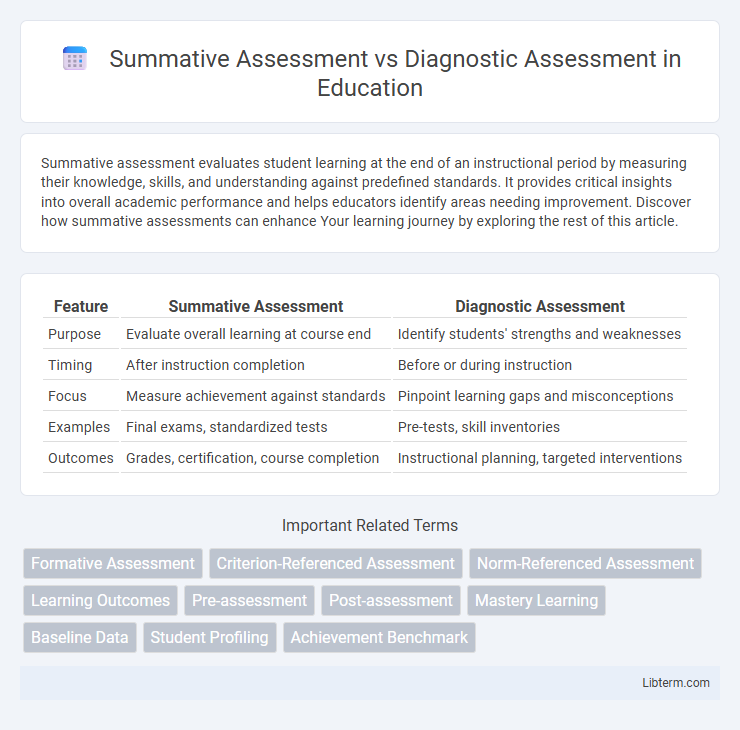Summative assessment evaluates student learning at the end of an instructional period by measuring their knowledge, skills, and understanding against predefined standards. It provides critical insights into overall academic performance and helps educators identify areas needing improvement. Discover how summative assessments can enhance Your learning journey by exploring the rest of this article.
Table of Comparison
| Feature | Summative Assessment | Diagnostic Assessment |
|---|---|---|
| Purpose | Evaluate overall learning at course end | Identify students' strengths and weaknesses |
| Timing | After instruction completion | Before or during instruction |
| Focus | Measure achievement against standards | Pinpoint learning gaps and misconceptions |
| Examples | Final exams, standardized tests | Pre-tests, skill inventories |
| Outcomes | Grades, certification, course completion | Instructional planning, targeted interventions |
Introduction to Summative and Diagnostic Assessment
Summative assessment evaluates student learning by measuring knowledge and skills at the end of an instructional period, providing a summary of achievement through tests, exams, or final projects. Diagnostic assessment identifies learners' strengths and weaknesses before or during instruction, offering detailed insights to tailor teaching strategies and address specific learning gaps. Both assessments play critical roles in educational planning, with summative assessments focusing on outcomes and diagnostic assessments emphasizing personalized support.
Defining Summative Assessment
Summative assessment evaluates student learning at the end of an instructional period, measuring overall achievement against established standards or benchmarks. This type of assessment includes final exams, standardized tests, and end-of-term projects, providing data to determine grades or advancement decisions. Its primary purpose is to summarize student performance and inform stakeholders about educational effectiveness.
Defining Diagnostic Assessment
Diagnostic assessment identifies students' prior knowledge, skills, and learning gaps before or during instruction to tailor teaching strategies effectively. Unlike summative assessment, which evaluates overall learning outcomes at the end of a course, diagnostic assessment provides detailed insights into specific areas needing improvement. This form of assessment uses tools like pre-tests, skill checklists, and learning inventories to inform personalized instruction plans.
Key Purposes of Summative Assessment
Summative assessment primarily aims to evaluate student learning at the end of an instructional period by measuring the extent to which educational goals and standards have been met. This type of assessment provides critical data for assigning grades, certifying competence, and informing stakeholders such as educators, students, and policymakers about overall academic achievement. Key purposes include summarizing student performance, guiding decisions on promotion or certification, and evaluating the effectiveness of instructional programs.
Key Purposes of Diagnostic Assessment
Diagnostic assessment serves to identify students' current knowledge, skills, and learning gaps before instruction begins, guiding personalized teaching strategies. It provides detailed insights into individual strengths and weaknesses, enabling educators to tailor interventions that address specific areas of difficulty. This targeted approach helps optimize learning outcomes by addressing challenges early and preventing future misunderstandings.
Major Differences Between Summative and Diagnostic Assessment
Summative assessment evaluates student learning at the end of an instructional period to measure overall achievement against standards or benchmarks, often resulting in grades or scores. Diagnostic assessment identifies students' existing knowledge, skills, and learning gaps before or during instruction to tailor teaching strategies and address specific needs. The primary difference lies in summative assessment's focus on final outcomes versus diagnostic assessment's emphasis on guiding ongoing learning interventions.
When to Use Summative Versus Diagnostic Assessment
Summative assessment is best used at the end of a learning period to evaluate overall student comprehension and mastery of specific content or skills. Diagnostic assessment is ideal before instruction begins, identifying students' existing knowledge gaps and learning needs for targeted intervention. Effective teaching requires using diagnostic assessments to inform instruction and summative assessments to measure educational outcomes.
Advantages and Limitations of Summative Assessment
Summative assessment provides a clear measure of student learning at the end of an instructional period, offering valuable data for grading and evaluating curriculum effectiveness. Its advantages include standardization and comparability across diverse learners, while limitations involve lack of immediate feedback and minimal support for ongoing learning improvements. This type of assessment often fails to address individual learning gaps, making it less effective for guiding instructional adjustments during the learning process.
Advantages and Limitations of Diagnostic Assessment
Diagnostic assessment provides detailed insights into students' prior knowledge and learning gaps, allowing educators to tailor instruction effectively and improve learning outcomes. Its advantage lies in early identification of individual weaknesses, enabling targeted interventions before progressing further. However, diagnostic assessments can be time-consuming to administer and analyze, and may require specialized training to interpret results accurately, limiting their practical use in large or diverse classrooms.
Best Practices for Effective Assessment Strategies
Effective summative assessments measure student learning outcomes at the end of instructional periods using standardized tests, final projects, or exams designed to evaluate overall achievement. Diagnostic assessments identify students' strengths and weaknesses before or during instruction through pre-tests, skill checklists, or formative quizzes, enabling targeted intervention and personalized learning plans. Combining clear learning objectives, timely feedback, and data-driven analysis ensures both assessments inform instruction and improve student performance.
Summative Assessment Infographic

 libterm.com
libterm.com